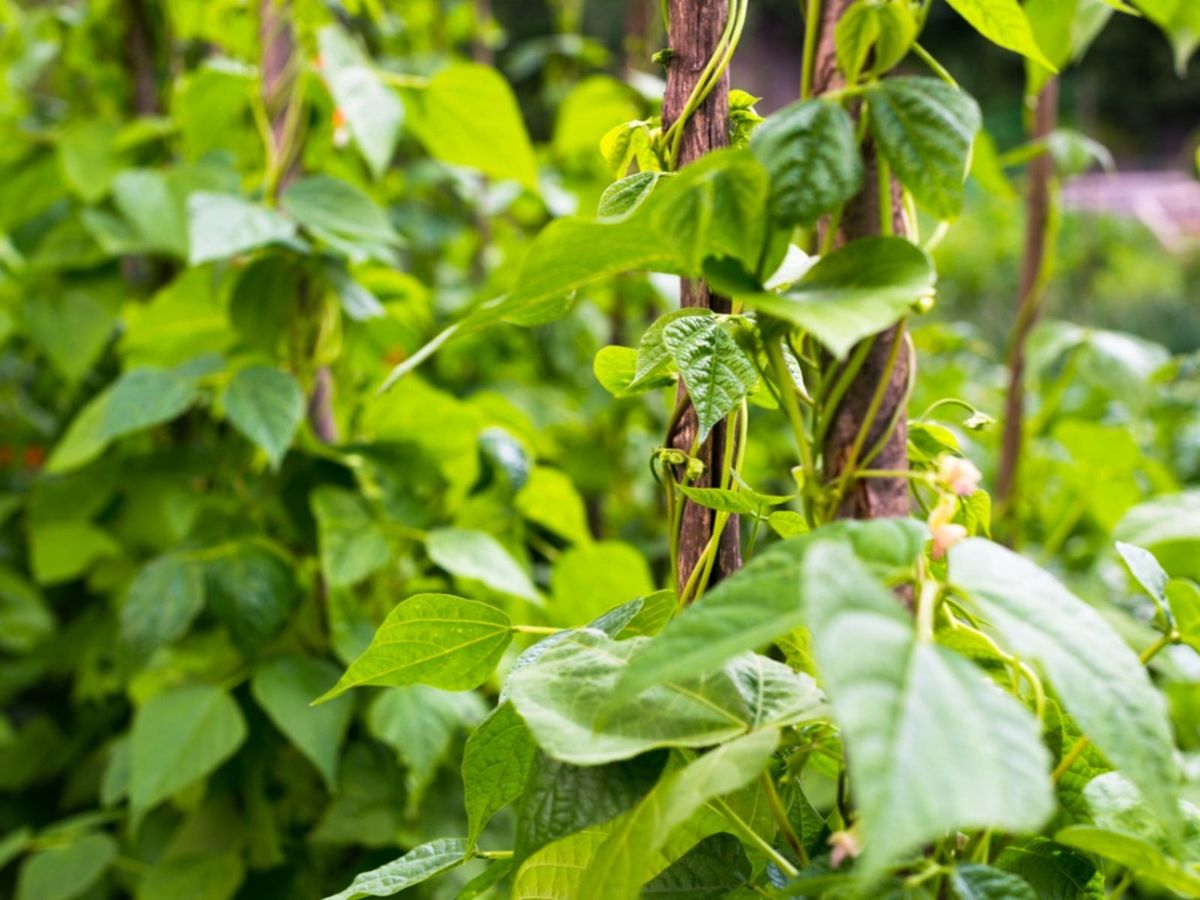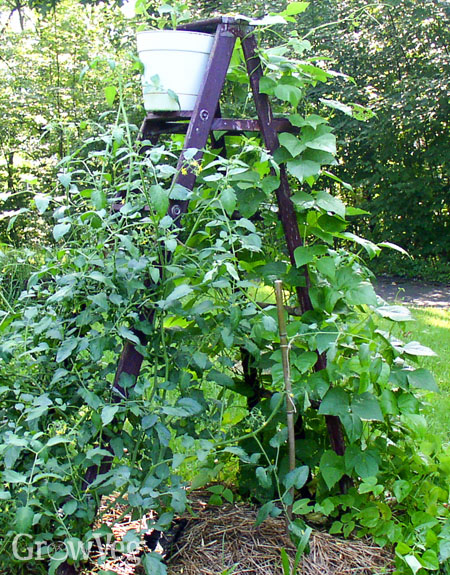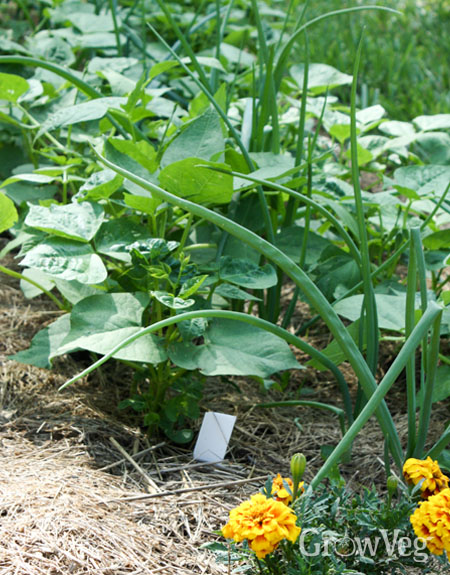There are a lot of reasons why beans go well with other vegetables. They grow quickly and are easy to take care of. Beans can grow in some shade, and most of their leaves have tiny hairs that hook onto other bugs and aphids. Since beans can fix nitrogen from the air, they don’t need as much of the soil’s nutrients as other vegetables do. Beans also deter weeds with their dense growth both above and below the ground.
How you use beans as companion plants depends on what you hope to accomplish. Pole beans can be used to make high walls that shade neighbors who are tired of the hot summer sun, and bush beans, which grow low, can be used to keep weeds from growing between rows of potatoes.
If you want to grow green or snap beans, you will need to have easy access to plants that grow on vines or bushes. These beans need to be picked every other day when the crop is ready. If you leave dry beans on the plants until the pods turn brown, you can just let them grow. This makes them a great choice for Native American-style Three Sisters plantings with corn, beans, and long-vined winter squash or pumpkins.
As a gardener, maximizing your planting space and yields is always top of mind. Have you considered growing pole beans and cucumbers together? These two vegetables actually make great companion plants in the garden when planted correctly.
In this complete guide, we’ll explore the benefits of pairing pole beans and cucumbers, optimal planting techniques, and tips for maximizing your harvest when intercropping these vining crops. Let’s get growing!
Why Companion Plant Pole Beans and Cucumbers?
Companion planting is the technique of strategically planting different vegetables together so they can benefit and support each other’s growth, There are several advantages to growing pole beans and cucumbers as companions
-
Utilize vertical and horizontal space efficiently – Pole beans are climbers and cucumbers are creepers.
-
Promote soil health – Pole beans fix nitrogen cucumbers need nitrogen. It’s a match!
-
Attract beneficial pollinators – Cucumber flowers bring in the bees to pollinate both crops.
-
Deter pests – Cucumbers emit a natural insect-repelling scent.
-
Improve shade and sun exposure – Pole beans like partial shade while cucumbers thrive in full sun.
-
Optimize garden yields – Intercropping leads to higher productivity in the same amount of space
When planted with care, pole beans and cucumbers can create a symbiotic growing environment with mutual benefits.
How to Plant Pole Beans and Cucumbers Together
To ensure your companion planting is successful, follow these tips when planting:
Timing
-
Sow seeds at the same time in early summer after the last frost.
-
Pole beans take 50-60 days to harvest, cucumbers 55-65 days.
Location
-
Give cucumbers full sun, plant pole beans to the north for partial shade.
-
Rotate planting spots each year to replenish soils.
Support Structures
-
Install trellises and cages for pole beans to climb up vertically.
-
Allow cucumber vines to sprawl at ground level uninhibited.
Spacing
-
Space pole bean seeds 6 inches apart, cucumber seeds 18-24 inches apart.
-
Offset rows around 3 feet to prevent overcrowding of vines.
Depth and Care
-
Plant both vegetables 1 inch deep in well-draining soil.
-
Water evenly, fertilize lightly, and mulch around plants.
Maximizing Yields When Growing Together
To optimize the yields of your pole bean and cucumber companion planting, incorporate these techniques:
-
Use vertical gardening methods for pole beans – Train vines up structures like trellises, cages, poles, and fencing to take advantage of vertical growing space. Go as high as 10 feet.
-
Interplant lettuce and radishes – Fill in space between pole bean and cucumber rows with quick-growing greens for diversity.
-
Use succession planting – After harvesting the first round of radishes or lettuce, replant more for continuous yields.
-
Add organic compost – Mix 1-2 inches into planting beds to nourish soil and boost fertility.
-
Use row covers – Protect plants from pests and create a greenhouse effect to accelerate growth.
-
Mulch around plants – Up to 3 inches of organic mulch retains moisture and suppresses weeds.
-
Scout for pests weekly – Identify and address any infestations promptly to maintain plant health.
FAQs About Growing Pole Beans and Cucumbers Together
If you’re new to interplanting pole beans and cucumbers, you probably have some questions. Here are answers to some of the most frequently asked questions about this companion pairing.
What are the optimal planting times for pole beans and cucumbers?
Plant pole bean and cucumber seeds at the same time in late spring to early summer after the last expected frost. This timing ensures warm soil and full sun exposure.
How far apart should pole beans and cucumbers be planted?
Space pole bean rows 6 inches apart and cucumber rows 18-24 inches apart. Offset the rows at least 3 feet to prevent overcrowding as vines spread.
How much sunlight do pole beans and cucumbers need?
Pole beans appreciate partial shade, so plant on the north side of cucumbers. Cucumbers require full sun exposure to thrive.
What type of support or trellis system do pole beans need?
Pole beans need a vertical structure at least 6-10 feet tall to climb up. Fencing, cages, poles, or trellises all work well.
How often and how much should you water pole beans and cucumbers?
These vegetables need consistent 1-2 inches of water per week from either rain or irrigation to grow their best.
Enjoy a Bountiful Harvest!
Now that you know the ins and outs of planting pole beans and cucumbers together, it’s time to put this companion gardening knowledge into practice! Follow the planting, care, and trellising steps outlined above, and you’ll be rewarded with a thriving vegetable patch and bountiful harvest.
The symbiotic relationship between pole beans and cucumbers makes them ideal candidates for interplanting. Plus, you’ll maximize garden space and improve yields. For a fun, productive gardening season, give companion planting with these vining veggies a try in your own yard.

Companion Planting with Pole Beans
You can grow long-vined peas like Sugar Snap with red runner beans or a strong pole bean like Kentucky Wonder on the same trellis. Plant the peas on the north or east side of an upright or A-frame trellis in the spring. About a month later, when the peas are at least 8 inches tall, plant the pole beans on the other side. When the weather warms in early summer, the peas will benefit from shade provided by the beans. After the peas are picked, the vigorous beans will quickly overtake both sides of the trellis.
Pole beans are good for beets, celery, lettuce, broccoli, cabbage, and other cool-season crops when planted so that they shade the other vegetables from the late afternoon sun. Where space is tight, some gardeners interplant pole beans with cucumbers or tomatoes on a shared trellis. This scheme works best when the tomatoes are well established by the time the beans are planted.

If you grow sweet corn, you have ready-made trellises for a late planting of pole beans. Plant pole beans at the ends of the rows of corn when it’s about a foot high. You can also use beans to fill in spaces between the rows of corn. By the time the sweet corn is ready to pick, the pole beans will be fully wrapped around the stalks. The beans will then scramble up and between the failing cornstalks, creating a hedge of heavy-bearing beans.
Marigolds have a reputation for protecting beans from pests, but studies have not observed fewer leaf-eating pests on beans grown with marigolds. However, it does appear that some bean varieties do grow better in the company of marigolds, which share beans liking for vibrant interactions with soil microbes. French researchers have identified over 112 strains of beneficial bacteria in bean root nodules, which may be one reason why beans respond so well to small amounts of vermicompost added to the soil, and to the close company of compatible plants.
Companion Planting with Bush Beans
Compact bush beans provide plenty of creative companion planting options in any type of garden. In large raised bed gardens, you could use summer savory or upright dill plants to hold up the ends of two rows of bush snap or filet beans. These are two herbs that are often cooked with green beans.
If you plant bush snap beans with potatoes, the potatoes will already be up and growing by the time the soil is warm enough for the beans. After your potatoes have been weeded and hilled, plant bush beans down the outside of the row. As the potatoes die back, the beans will help keep the soil shaded and cool.
Or, try this companion planting idea intended to protect beans from pests. Plant bush beans after spring radishes, cilantro or arugula, with a few of the bolting plants left behind. Radish, cilantro and arugula flowers attract beneficial insects, and can help to confuse pests in search of beans. You can also interplant bush beans with onions to deter pests from both crops.

